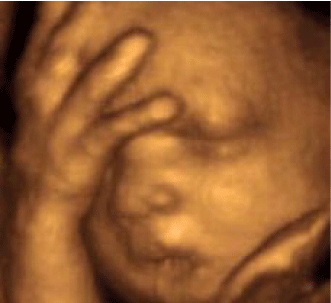Clinical Image
Fetal Transmission in a 26 Year Old Primigravida with Fibromuscular Dysplasia
Roland Brilla*
Department of Neurology, University of Wisconsin, USA
*Corresponding author: Roland Brilla, Department of Neurology, University of Wisconsin, UW Madison, USA
Published: 24 Oct, 2016
Cite this article as: Brilla R. Fetal Transmission in a 26 Year
Old Primigravida with Fibromuscular
Dysplasia. Ann Clin Case Rep. 2016;
1: 1162.
Abstract
Evidence for fetal transmission with the extrauterine environment has been reported rarely in the literature. Here, we report a well-documented case of a 26 year old primigravida patient who experienced pregestational fetal communication. We also discuss the comorbidity of fibromuscular dysplasia (FMD).
Clinical Image
We report a case of a 26 year old primigravida with an asymptomatic and undiagnosed abdominal routine antenatal care and serial ultrasound reports. She presented for a routine antenatal care visit at 31 weeks of gestation. While in side position on the ultrasound table, the ultrasound technician inadvertently performed a repetitive percussion with the head of the probe, resulting in a “Knock Knock“ on the abdominal wall. A few seconds later, both the technician and the patient clearly understood the fetal response “ Who is there?“, it is unclear whether this was verbal or telepathic communication. The ultrasound technician replied, in jest, “banana“, to which again the reply “ Banana who? “ or possibly “ Banana Joe“ was understood. After the mother’s reply “Aren’t you happy it is your mummsy mom?“, no further communication was noted. Unfortunately, we did not see an indication to use onabotulinum toxin [1-3]. The actual ultrasound was unremarkable (Figure 1). Delivery of a healthy male infant was spontaneous, vaginal and at term; her recovery was uneventful and mother and child were discharged on the second post-partum day, in good condition.
Discussion
This is to our best knowledge, the first report of sustained maternal-fetal bidirectional
communication. It is unclear whether this was verbal or telepathic communication [4]. It is
furthermore unclear whether reference was made to an Italian movie [5], a movie that - as the
author later learned - was unknown to the mother and, presumably, to the fetus as well. The possible
contribution by the patient’s comorbidity of FMD is complex and almost impossible to delineate.
That spontaneous cervical artery dissection, as has been described by others during pregnancy [6],
would be responsible for this extraordinary phenomenon remains speculative.
This case demonstrates the importance of compassion during
pregnancy and delivery, even outside of the context of monozygotic
twin sisters [7]. Further research is needed on modalities and content
of transuterine maternal-fetal transmission.
Figure 1
Conclusion
Prompt diagnosis which requires high index of suspicion and following basic principles of managing fracture i.e. examining and radiologically investigating the joint above and below the fracture yield in favourable outcome and good results.
References
- Krueger CA, Cave EC, Garvan C. Fetal response to live and recorded maternal speech. Biol Res Nurs. 2015; 17: 112-120.
- McArdle A, Flenady V, Toohill J, Gamble J, Creedy D. How pregnant women learn about foetal movements: sources and preferences for information. Women Birth. 2015; 28: 54-59.
- El-Khawand D, Wehbe S, Whitmore K. Botulinum toxin for conditions of the female pelvis. Int Urogynecol J. 2013; 24: 1073-1081.
- Halasa TK, Surapaneni L, Sattur MG, Pines AR, Aoun RJ, Bendok BR. Human Brain-to-Brain Interface: Prelude to Telepathy. World Neurosurg. 2015; 84: 1507-1508.
- Pedersoli C “Banana Joe” Italy 1982 Ishaq Mohammed, Maria Aaland, Nasrin Khan et al. A young pregnant woman with spontaneous carotid artery dissection-unknown mechanisms. BMJ Case Rep. 2014; 2014: bcr2013202541.
- Mohammed I, Aaland M, Khan N, Crossley I. A young pregnant woman with spontaneous carotidartery dissection-unknown mechanisms. BMJ Case Rep. 2014; 2014: bcr2013202541.
- Habek D, Jukić V, Prka M, Pavlović M, Mihalić A. Both compassion of monozygotic twin sisters during the delivery and pregnancy. Psychiatr Danub. 2016; 28: 195.

